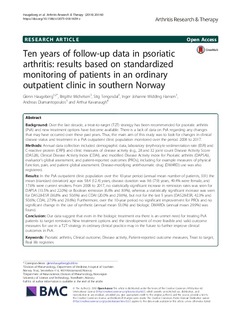| dc.contributor.author | Haugeberg, Glenn | |
| dc.contributor.author | Michelsen, Brigitte | |
| dc.contributor.author | Tengesdal, Stig | |
| dc.contributor.author | Hansen, Inger Johanne Widding | |
| dc.contributor.author | Diamantopoulos, Andreas P | |
| dc.contributor.author | Kavanaugh, Arthur | |
| dc.date.accessioned | 2019-09-03T06:48:28Z | |
| dc.date.available | 2019-09-03T06:48:28Z | |
| dc.date.created | 2018-10-01T19:44:31Z | |
| dc.date.issued | 2018 | |
| dc.identifier.citation | Arthritis Research & Therapy. 2018, 20:160 1-12. | nb_NO |
| dc.identifier.issn | 1478-6354 | |
| dc.identifier.uri | http://hdl.handle.net/11250/2612119 | |
| dc.description.abstract | Background: Over the last decade, a treat-to-target (T2T) strategy has been recommended for psoriatic arthritis (PsA) and new treatment options have become available. There is a lack of data on PsA regarding any changes that may have occurred over these past years. Thus, the main aim of this study was to look for changes in clinical disease status and treatment in a PsA outpatient clinic population monitored over the period 2008 to 2017. Methods: Annual data collection included demographic data, laboratory (erythrocyte sedimentation rate (ESR) and C-reactive protein (CRP)) and clinic measures of disease activity (e.g., 28 and 32 joint count Disease Activity Score (DAS28), Clinical Disease Activity Index (CDAI), and modified Disease Activity index for Psoriatic arthritis (DAPSA)), evaluator’s global assessment, and patient-reported outcomes (PROs), including for example measures of physical function, pain, and patient global assessment. Disease-modifying antirheumatic drug (DMARD) use was also registered. Results: In the PsA outpatient clinic population over the 10-year period (annual mean number of patients, 331) the mean (standard deviation) age was 58.4 (12.4) years, disease duration was 9.6 (7.9) years, 49.4% were female, and 17.6% were current smokers. From 2008 to 2017, no statistically significant increase in remission rates was seen for DAPSA (13.5% and 22.0%) or Boolean remission (6.6% and 8.9%), whereas a statistically significant increase was seen for DAS28-ESR (36.8% and 50.6%) and CDAI (20.0% and 29.6%), but not for the last 5 years (DAS28-ESR, 42.3% and 50.6%; CDAI, 27.9% and 29.6%). Furthermore, over the 10-year period no significant improvement for PROs and no significant change in the use of synthetic (annual mean 53.0%) and biologic DMARDs (annual mean 29.9%) was found. Conclusion: Our data suggest that even in the biologic treatment era there is an unmet need for treating PsA patients to target remission. New treatment options and the development of more feasible and valid outcome measures for use in a T2T strategy in ordinary clinical practice may in the future to further improve clinical outcomes in PsA. | nb_NO |
| dc.language.iso | eng | nb_NO |
| dc.publisher | BMC (part of Springer Nature) | nb_NO |
| dc.rights | Navngivelse 4.0 Internasjonal | * |
| dc.rights.uri | http://creativecommons.org/licenses/by/4.0/deed.no | * |
| dc.title | Ten years of follow-up data in psoriatic arthritis: Results based on standardized monitoring of patients in an ordinary outpatient clinic in southern Norway | nb_NO |
| dc.type | Journal article | nb_NO |
| dc.type | Peer reviewed | nb_NO |
| dc.description.version | publishedVersion | nb_NO |
| dc.source.pagenumber | 1-12 | nb_NO |
| dc.source.volume | 20:160 | nb_NO |
| dc.source.journal | Arthritis Research & Therapy | nb_NO |
| dc.identifier.doi | 10.1186/s13075-018-1659-z | |
| dc.identifier.cristin | 1616939 | |
| dc.description.localcode | © The Author(s). 2018 Open Access This article is distributed under the terms of the Creative Commons Attribution 4.0 International License (http://creativecommons.org/licenses/by/4.0/) | nb_NO |
| cristin.unitcode | 194,65,30,0 | |
| cristin.unitname | Institutt for nevromedisin og bevegelsesvitenskap | |
| cristin.ispublished | true | |
| cristin.fulltext | original | |
| cristin.qualitycode | 2 | |

